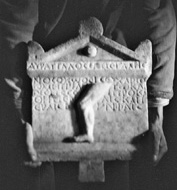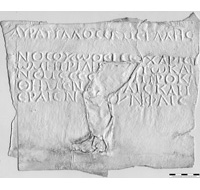 MAMA XI 70 (Sebaste)
MAMA XI 70 (Sebaste) 
Votive stele of Aur. Agathos
- Type of monument:
- Votive stele.
- Location:
- Sivaslı (Sebaste): in private possession.
- Description:
- Marble stele with pediment and acroteria above and tenon below. On the shaft, human leg in relief.
- Dimensions:
- Ht. 0.43; W. 0.33 (top), 0.30 (shaft), 0.34 (base); Th. 0.08; letters 0.010-0.022.
- Record:
- Squeeze; line drawing; MB notebook copy; photograph (1955/125).
- Publication:
- None; mentioned by Ricl 1992: 95 n.102 (‘dans le musée d’Uşak’); (Paz de Hoz 1999: 240, 40.26).
- Date:
- Third century AD.
Αὐρ. Ἄτταλος ἐγ μεγάλης
νόσου σωθεὶς εὐχαριστ-
ῶ Μητρὶ Λητῷ καὶ
Νεμέσεσι προκα-
5θημέναις καὶ ἱ-
εραῖς Νύνφαις
I, Aur. Attalos, having been saved from a great illness, thank Mother Leto and the presiding Nemeseis and the sacred nymphs.





This monument is a εὐχαριστήριον, an ex-voto expression of gratitude after recovery from illness. For the use of the verb εὐχαριστεῖν in votives of the second and third centuries AD, see Robert, Hellenica X, 55-8; for salvation ‘from great illness’, compare SEG 53, 1168 (Lepcis Magna), ἐκ μεγάλης νόσου διασωθεὶς εὐχαριστήριον ἀνέθηκα.
The goddess Meter Leto seems only to be attested in a relatively small stretch of territory in southern Phrygia and eastern Lydia. She is particularly associated with the god Apollo Lairbenos, whose sanctuary lay in the loop of the Maeander river north of Hierapolis-Pamukkale, near modern Bahadınlar. An inscription from the sanctuary of Apollo Lairbenos records the construction of a stoa in honour of Μητρὶ Λητοῖ καὶ Ἡλίῳ Ἀπόλλωνι Λυερμηνῷ (Bahadınlar: Ritti, Şimşek and Yıldız 2000: 8, D5), suggesting that she was formally worshipped alongside Apollo at this sanctuary. An ex-voto, also from the sanctuary of Apollo Lairbenos, records the fulfilment of the vow of Aphias, daughter of Theodotos, to Meter Leto: εὐχαριστῶ Μητρὶ Λητῷ, ὅτι ἐξ ἀδυνάτων δυνατὰ πυεῖ... Μητρὶ Λητῷ εὐχήν (Ortaköy: Ritti, Şimşek and Yıldız 2000: 12, D18). Another ex-voto to Meter Leto is known from the close vicinity of the sanctuary, on the opposite bank of the Maeander in the Çal ovası (Bekilli, possibly the ancient Dionysopolis: MAMA IV 314).
In eastern Lydia, attestations of the goddess are more widely dispersed. An ex-voto of the νέοι φιλάνπελοι to Meter Leto is known from the modern village of Hayallı, on the north-east flank of the Kogamos valley, on the borders of the territories of Philadelpheia and Maionia (TAM V 3, 1556); another ex-voto to Meter Leto, set up by a certain Tyrannis of Philadelpheia, was found at the modern town of Buldan, north-west of the confluence of the Maeander and Lykos rivers, on the borders of the territories of Apollonia-Tripolis and Sala (SEG 29, 1154; for the location of Sala, see Thonemann 2008: 50-1). Further to the north, in the upper Hermos valley north of Kollyda, the inhabitants of the villages of Dima and Kerbia dedicated a statue of Meter Leto ‘on the order of Apollo’: οἱ [ἐ]ν Διμοις [καὶ Κερβιοις] κάτοικοι Μητέρα Λητὼ ἀνέστησαν κατ᾿ ἐπιταγὴν τοῦ Ἀπόλλωνος (Ayazviran: TAM V 1, 489). Two further votive dedications from Lydia name the goddess simply as Leto, without the title Meter: I.Manisa 85 (unknown provenance); TAM V 1, 250 (Kula: Ἀπολώνιος Δραλλᾶς δυνατῇ θεῷ εὐχαριστῶ Λητῷ).
A cult of Apollo Lairbenos and Meter is already attested at Sebaste, thanks to an ex-voto from the Byzantine church near Selçikler: Ἀμμία Μελίτωνος Ἡλίῳ Λερβήνῳ καὶ Μητρὶ εὐχήν (Ritti, Şimşek and Yıldız 2000: 10, D12). J. and L. Robert (BE 1954, 233) noted that the stele could either have been transported to Sebaste from the sanctuary of Apollo Lairbenos at Bahadınlar, or could derive from a ‘branch’ sanctuary of Apollo Lairbenos and Meter Leto on the territory of Sebaste (an ἀφίδρυμα: Robert, Hellenica XIII, 120). This ‘branch’ sanctuary is in fact directly attested in an unpublished inscription from Payamalanı, on display in the Uşak museum, recording the dedication by the inhabitants of the village of Eibeos ([ἡ] Ειβεανῶν κατοικ⟨ί⟩α) of a temple (ναόν) and cult-statue (ἀνδρ[ιάντα]) to Ἡλίῳ Ἀπόλλωνι Λαιρ[μηνῷ].
One further possible attestation of the cult of Meter Leto at Sebaste derives from a dedication of unknown provenance, which appeared on the London antiquities market in 1989: Ἀπόλλω[νι] Ἀ̣λ̣σί̣ῳ κ̣α̣ὶ̣ Μητρὶ Λητῷ ὑπὲρ [Σ]τατειλίου Κα[ικιλι(?)]ανοῦ καὶ Στατειλίας Ἀ̣μμίας τῆς γυναικὸς αὐτοῦ Ἰούλιος Μαξίμου ἀνέθηκεν (SEG 39, 1726). The dedication is of a type characteristic of Phrygia; what seems to be the only Phrygian attestation of the rare gentilician Statilius comes from Sebaste (IGR IV 688: Statilia Kalligone). For the cult epithet Alsios carried by Apollo, compare the cult of Apollo Alsenos at Akmoneia (Drew-Bear and Naour 1990: 1933-9).
The Nemeseis seem not to be otherwise attested at Sebaste. They appear on the coinage of Dionysopolis, a near neighbour of Sebaste to the south-west (von Aulock 1987: 56, no. 82), and Amorion (SNG von Aulock 3406); they are also depicted on a votive relief to Apollo from the ancient rural sanctuary at Çavdarlı near Afyon (Robert 1987: 338-9). North-east of Sebaste, in Lydia Katakekaumene, the Nemeseis appear in a funerary inscription from Maionia (SEG 34, 1202: τὰς Νεμέσις σοι, μή τίς μοι τὴν στήλην ἀδικήσεις), and in a confession inscription from the village of Perkos/on (SEG 38, 1236: μεγάλαι Νεμέσις ἐν Περκῳ). In a dedication from the village of Axiotta in eastern Lydia, it is not clear whether the Nemeseis are invoked as separate deities or as qualities of the presiding deity of the village, Men Artemidorou (SEG 53, 1344: μεγάλαι σαι νεμέσεις). The epithet προκαθήμεναι is elsewhere used of the ‘presiding’ or patron deities of a community: compare I.Ephesos 3252 (Almourenon katoikia) lines 7-8, τῷ προκαθημένῳ τῆς κώμης Μηνί; Syll.3 694 (Pergamon) lines 49-51, τῆι τε [Δή]μητρι καὶ τῆι Κόρ[ηι ταῖς π]ροκαθημέναις [θε]αῖς τῆς πόλεως ἡμ[ῶν]; IAph2007 8.37, line 5, τὴν προκαθημένην τῆς πόλεως ὑμ[ῶν θεόν].